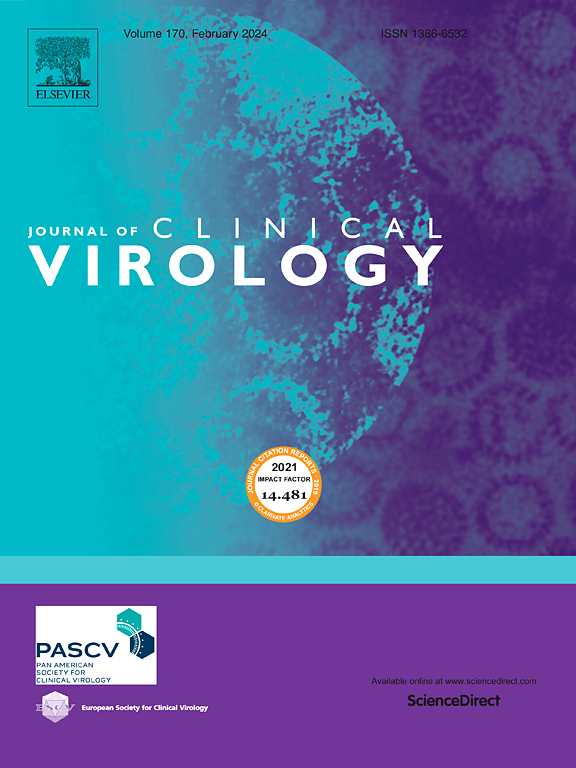检测埃博拉病毒和苏丹病毒的抗原快速诊断试验的实验室评价
IF 3.4
3区 医学
Q2 VIROLOGY
引用次数: 0
摘要
基于核酸的检测是诊断丝状病毒的金标准,包括埃博拉病毒(EBOV)和苏丹病毒(SUDV)。然而,在实验室基础设施有限的地区暴发的疫情突出表明,需要能够在现场快速和安全使用的更简单的诊断测试。方法对8种抗原快速诊断试验(Ag-RDTs)检测EBOV和SUDV的能力进行评价。使用病毒细胞浆液分析板评估检测限,并对临床样品进行测试以确定敏感性和特异性。结果5个Ag-RDTs检测到EBOV, 3个检测到SUDV,尽管临床敏感性较低(EBOV为20 - 40%,SUDV为33%),但只有在病毒载量较高时才有所改善。所有试验均显示100%的临床特异性,无交叉反应性。尽管所有被评估的ag - rdt都不适合常规诊断,但有些可能在高病毒载量的情况下有用,如尸体检测。我们的研究结果强调了提高Ag-RDT灵敏度或开发高灵敏度的即时分子诊断的必要性。本文章由计算机程序翻译,如有差异,请以英文原文为准。
Laboratory evaluation of antigen rapid diagnostic tests to detect Ebola and Sudan viruses
Background
Nucleic acid-based assays are the diagnostic gold standard for filoviruses, including Ebola (EBOV) and Sudan (SUDV) viruses. However, outbreaks in areas with limited laboratory infrastructure highlight the need for simpler diagnostic tests that can be rapidly and safely used in the field.
Methods
We evaluated eight antigen rapid diagnostic tests (Ag-RDTs) for their ability to detect EBOV and SUDV. Analytical panels using virus cell slurries were used to assess limit of detection, and clinical samples were tested to determine sensitivity and specificity.
Results
Five Ag-RDTs detected EBOV and three detected SUDV, although clinical sensitivity was low (20–40 % for EBOV, 33 % for SUDV), improving only with higher viral loads. All assays demonstrated 100 % clinical specificity with no cross-reactivity.
Discussion
Although none of the evaluated Ag-RDTs are suitable for routine diagnosis, some may be useful in high viral load contexts such as cadaver testing. Our findings highlight the need to improve Ag-RDT sensitivity or develop high-sensitivity point-of-care molecular diagnostics.
求助全文
通过发布文献求助,成功后即可免费获取论文全文。
去求助
来源期刊

Journal of Clinical Virology
医学-病毒学
CiteScore
22.70
自引率
1.10%
发文量
149
审稿时长
24 days
期刊介绍:
The Journal of Clinical Virology, an esteemed international publication, serves as the official journal for both the Pan American Society for Clinical Virology and The European Society for Clinical Virology. Dedicated to advancing the understanding of human virology in clinical settings, the Journal of Clinical Virology focuses on disseminating research papers and reviews pertaining to the clinical aspects of virology. Its scope encompasses articles discussing diagnostic methodologies and virus-induced clinical conditions, with an emphasis on practicality and relevance to clinical practice.
The journal publishes on topics that include:
• new diagnostic technologies
• nucleic acid amplification and serologic testing
• targeted and metagenomic next-generation sequencing
• emerging pandemic viral threats
• respiratory viruses
• transplant viruses
• chronic viral infections
• cancer-associated viruses
• gastrointestinal viruses
• central nervous system viruses
• one health (excludes animal health)
 求助内容:
求助内容: 应助结果提醒方式:
应助结果提醒方式:


